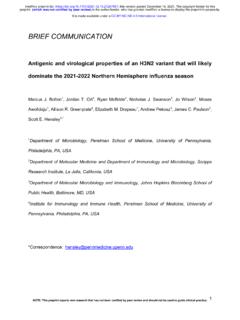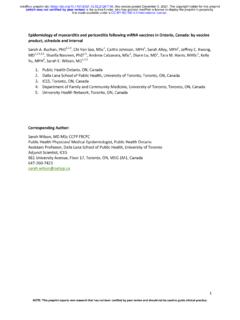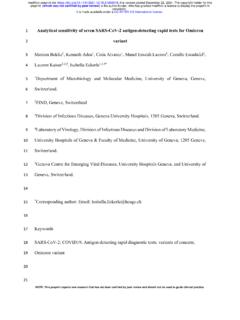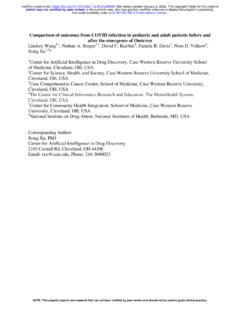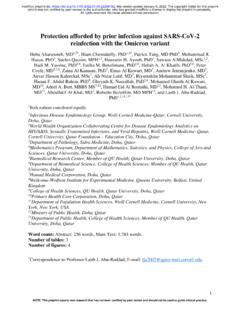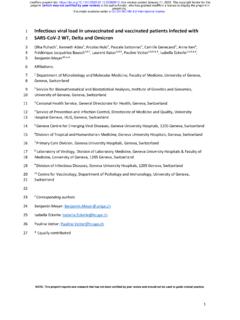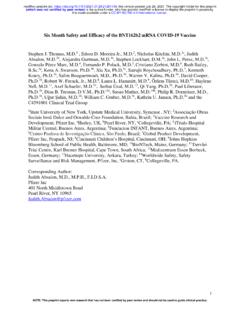Transcription of Saliva swabs are the preferred sample for Omicron detection
1 Saliva swabs are the preferred sample for Omicron 1 detection 2 3 Gert Marais1, Nei-yuan Hsiao2, Arash Iranzadeh2, Deelan Doolabh2, Annabel Enoch3 4 Chun-yat Chu1, Carolyn Williamson2, Adrian Brink1, Diana Hardie2,* 5 6 1 Department of Medical Microbiology, University of Cape Town, Cape Town, South 7 Africa 8 2 Department of Medical Virology, University of Cape Town, Cape Town, South Africa 9 3 Green Point Diagnostic Virology Laboratory, National Health Laboratory Service, 10 Cape Town, South Africa 11 12 *Corresponding author 13 Email: 14 15 16 . CC-BY International licenseIt is made available under a perpetuity. is the author/funder, who has granted medRxiv a license to display the preprint in(which was not certified by peer review)preprint The copyright holder for thisthis version posted December 24, 2021. ; : medRxiv preprint NOTE: This preprint reports new research that has not been certified by peer review and should not be used to guide clinical 17 18 The Omicron variant is characterised by more than 50 distinct mutations, the majority 19 of which are located in the spike protein.
2 The implications of these mutations for 20 disease transmission, tissue tropism and diagnostic testing are still to be determined. 21 We evaluated the relative performance of Saliva and mid-turbinate swabs as RT-22 PCR samples for the Delta and Omicron variants. The positive percent agreement 23 (PPA) of Saliva swabs and mid-turbinate swabs to a composite standard was 71% 24 (95% CI: 53-84%) and 100% (95% CI: 89-100%), respectively, for the Delta variant. 25 However, for the Omicron variant Saliva and mid-turbinate swabs had a 100% (95% 26 CI: 90-100%) and 86% (95% CI: 71-94%) PPA, respectively. This finding supports 27 ex-vivo data of altered tissue tropism from other labs for the Omicron variant. 28 Reassessment of the diagnostic testing standard-of-care may be required as the 29 Omicron variant become the dominant variant worldwide.
3 30 . CC-BY International licenseIt is made available under a perpetuity. is the author/funder, who has granted medRxiv a license to display the preprint in(which was not certified by peer review)preprint The copyright holder for thisthis version posted December 24, 2021. ; : medRxiv preprint Introduction 31 32 SARS-CoV-2 variants are characterised by distinct mutations which impact on 33 disease transmissibility, immune escape, diagnostics and possibly tissue tropism. 34 Omicron , in particular, has an extraordinary number of mutations, with at least 50 35 mutations across the genome, 30 of which are located in the spike protein and 15 in 36 the receptor binding While functional change in terms of receptor binding is 37 currently to be elucidated, the pattern of viral shedding and resulting impact on 38 diagnostic sampling methods is currently unknown.
4 39 40 Methods 41 42 As part of an on-going study2 to evaluate the diagnostic performance of different 43 sample types, we recruited 382 acutely symptomatic, non-hospitalised patients who 44 presented for SARS-CoV-2 testing between August and December 2021 at the 45 Groote Schuur Hospital COVID testing centre in Cape Town. Paired mid-turbinate 46 (MT) and Saliva (SA) swabs were collected and tested by RT-PCR (Supplementary 47 methods). 48 49 Samples were classified as Omicron or Delta based on whole genome sequencing 50 data, diagnostic PCR target failures and sampling date (Supplementary 51 methods).1,3,4 A composite standard for SARS-CoV-2 infection was used for 52 comparison of sample types, with infection considered present if SARS-CoV-2 RNA 53 was detected on either the MT or matched SA swab. 54 55 . CC-BY International licenseIt is made available under a perpetuity.
5 Is the author/funder, who has granted medRxiv a license to display the preprint in(which was not certified by peer review)preprint The copyright holder for thisthis version posted December 24, 2021. ; : medRxiv preprint Results 56 57 The positive percent agreement (PPA) of SA swabs and MT swabs to this standard 58 was 71% (95% CI: 53-84%) and 100% (95% CI: 89-100%), respectively, for the 59 Delta variant. This was similar to our previous findings for the Beta 60 However, for the Omicron variant SA and MT swabs had a 100% (95% CI: 90-100%) 61 and 86% (95% CI: 71-94%) PPA, respectively (Supplementary Figure 1). The mean 62 RT-PCR cycle threshold differences between MT and SA, using the nucleocapsid 63 gene target as a reference, were (SD , P< ) and (SD , 64 P= ) for Delta and Omicron respectively. The median time from symptom onset to 65 positive test for Delta and Omicron assigned cases was 3 days (range: 1-10) and 2 66 days (range: 0-7).
6 67 68 Conclusion 69 70 These findings suggest that the pattern of viral shedding during the course of 71 infection is altered for Omicron with higher viral shedding in Saliva relative to nasal 72 samples resulting in improved diagnostic performance of Saliva swabs . This supports 73 the ex-vivo finding of improved viral replication in upper respiratory tract tissue and 74 possibly altered tissue This is an important finding as the current standard 75 of care for diagnosis using swabs of the nasal or nasopharyngeal mucosa may be 76 suboptimal for the Omicron variant. 77 78 79 . CC-BY International licenseIt is made available under a perpetuity. is the author/funder, who has granted medRxiv a license to display the preprint in(which was not certified by peer review)preprint The copyright holder for thisthis version posted December 24, 2021.
7 ; : medRxiv preprint References 80 81 1. Viana R, Moyo S, Amoako DG, et al. Rapid epidemic expansion of the SARS-82 CoV-2 Omicron variant in southern Africa. medRxiv 2021 83 2. Chu CY, Marais G, Opperman C, et al. Performance of Saliva and mid-84 turbinate swabs for detection of the beta variant in South Africa. The Lancet 85 Infectious Diseases 2021. 86 3. Valley-Omar Z, Marais G, Iranzadeh A, et al. Reduced amplification efficiency 87 of the RNA-dependent-RNA-polymerase (RdRp) target enables tracking of the Delta 88 SARS-CoV-2 variant using routine diagnostic tests. medRxiv 89 2021 90 4. Scott L, Hsiao N-y, Moyo S, et al. Track Omicron s spread with molecular 91 data. Science Commentary 2021:eabn4543. 92 5. HKUMed finds Omicron SARS-CoV-2 can infect faster and better than Delta 93 in human bronchus but with less severe infection in lung.
8 2021. (Accessed 16 94 December 2021, at cov-2-96 infection?utm_medium=social&utm_source=t witter&utm_campaign=press_release.) 97 98 99 . CC-BY International licenseIt is made available under a perpetuity. is the author/funder, who has granted medRxiv a license to display the preprint in(which was not certified by peer review)preprint The copyright holder for thisthis version posted December 24, 2021. ; : medRxiv preprint Acknowledgements 100 101 This research was funded in whole, or in part, by Wellcome [203135/Z16/Z]. For the 102 purpose of Open Access, the author has applied a CC BY public copyright licence to 103 any Author Accepted Manuscript version arising from this submission. 104 105 Testing was conducted at the Groote Schuur Hospital and Green Point National 106 Health Laboratory Service diagnostic virology laboratories.
9 107 108 Ethics statement 109 110 This research has been approved by the University of Cape Town Human Research 111 Ethics Committee (Ref: 420/2020). 112 113 Conflict of interests 114 115 The authors declare no conflict of interest 116 . CC-BY International licenseIt is made available under a perpetuity. is the author/funder, who has granted medRxiv a license to display the preprint in(which was not certified by peer review)preprint The copyright holder for thisthis version posted December 24, 2021. ; : medRxiv preprint Figures 117 118 119 Figure 1. The cycle threshold (Ct) or cycle number (CN) values for paired mid-120 turbinate (MT) and Saliva (SA) swabs are shown for Delta and Omicron variant 121 positive samples. Paired samples were tested on the same diagnostic platform on 122 the same day and samples where only the MT or SA swab was positive were 123 excluded from the analysis.
10 The nucleocapsid (N) gene Ct value was used for 124 analysis if the sample was tested with the Allplex 2019-nCoV assay (Seegene, 125 South Korea). This was because the Delta and Omicron variants are not associated 126 with N gene target failure and other assays used also target the N gene. Statistical 127 MT swabs - DeltaSA swabs - DeltaMT swabs - OmicronSA swabs - Omicron 10203040Ct/CN Value ns . CC-BY International licenseIt is made available under a perpetuity. is the author/funder, who has granted medRxiv a license to display the preprint in(which was not certified by peer review)preprint The copyright holder for thisthis version posted December 24, 2021. ; : medRxiv preprint analysis consisted of paired t-tests performed using GraphPad Prism version 128 for macOS, GraphPad Software, San Diego, California USA, 129 The bar represents the mean Ct value with error bars showing 1 standard deviation.
